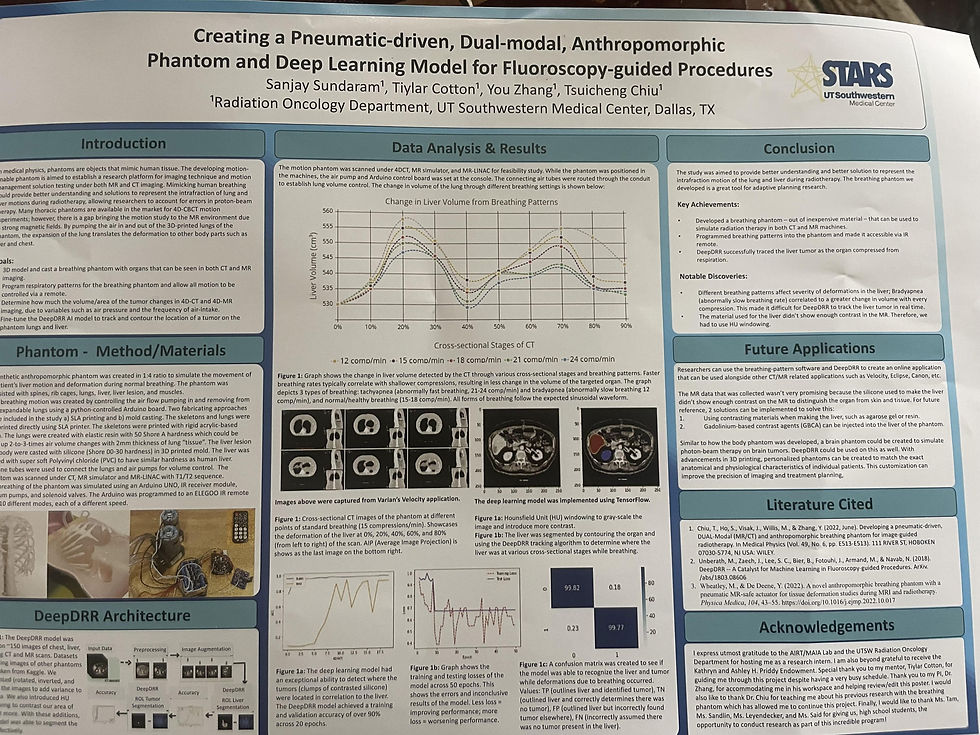The Internship & The Poster
- Sanjay Sundaram
- Jul 4, 2024
- 3 min read
Updated: Aug 19, 2024
The most tricky part of my internship was definitely creating the poster. This task came towards the end of the eight-week program, and it was a whirlwind of activity and effort. Reflecting on my internship, I’d split the experience into three main sections.

The first section, which lasted about two weeks, was all about learning. I spent this time getting acquainted with what my lab does, reading research papers, helping with minor tasks, and understanding the therapeutic methods and techniques used. My hours varied, typically ranging from six to nine each day, but it wasn’t a consistent eight-hour grind.
The next three and a half to four weeks were laser-focused on producing tangible results. I wanted to create something notable that my lab could use in future research. This period was all about conducting experiments, creating phantoms, assisting professors with CT and MR scans, and working on coding and electronics. It was hands-on and intense, but incredibly rewarding. I was determined to show my lab that I could contribute meaningfully.
The final two to two and a half weeks were dedicated to the poster. This was crunch time, and it was the most demanding part of the entire internship. Not only did I have to finalize my project, but I also had to create and polish the research poster for the presentation on the last day of the internship, which was on July 26th.
Creating the poster required a tremendous amount of effort in a short period. My lab still expected me to wrap up my project and produce visual results to include in the poster. The pressure was on because the previous weeks had been spent iterating and refining the project. Collecting data and producing results in just a week and a half was stressful. I had to figure out what to graph, how to create those graphs, and where to obtain the necessary CT and MR images.
Getting the CT and MR scans wasn't as simple as snapping a few pictures. It involved scheduling appointments for the scans, which took time because the machines were often in use for clinical purposes. Working in a clinical setting meant navigating around patient schedules, making the process even more challenging. Plus, we were dealing with radiation, so safety precautions were a must.
Despite these obstacles, I managed to get the scans done. I took our phantom body and put it through the CT and MR machines, ensuring we had the images needed for the poster. This process was time-consuming and required meticulous planning, but it was crucial for the final presentation.
Figuring out the coding part was another major hurdle. Making sure all the code worked seamlessly was essential for presenting our data accurately. It involved a lot of troubleshooting and tweaking, which added to the overall challenge.
By the time I got to the poster presentation, I was exhausted but proud. Seeing all my hard work come together in the form of a polished, informative poster was incredibly satisfying. My friends and I, dressed up in our suits, showcased our posters, marking the end of an intense but fulfilling internship.
Looking back, those last two weeks were a blur of activity, stress, and intense focus. But they were also the most rewarding part of the internship. They taught me about perseverance, time management, and the importance of thorough preparation. Despite the challenges, I came out of the experience with a sense of accomplishment and a deeper understanding of the research process.
So, that’s the story of how the poster creation became the most challenging part of my internship. It pushed me to my limits, but it also showed me what I’m capable of when I’m determined and focused. This experience was a significant milestone in my journey, and I’m grateful for every moment of it.



Comments